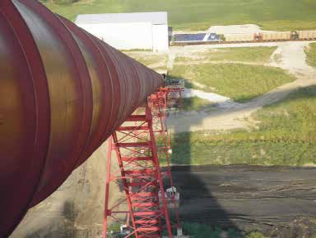Raymond Perr, P.E.
This is an article that was published in the October 2014 version of World Coal, the leading source of news for the coal industry
Design of flood-proof coal handling solutions on the Ohio River
The strain coal transshipment facility occupies a 500 acre (202 ha.) site on the northern shore of the Ohio River, downstream of Evansville, Indiana, in the US. The site receives, unloads, stores, reclaims and transfers from rail to barge the coal that is mined in the owner ’s multiple coal mines. The coal mines are located in the Southern Illinois Basin.
The facility is in a flood plane of the Ohio River, which presents a number of challenges. Finding suitable solutions would allow coal operations to continue even during high water events on the river. A standard material handling system would not meet all the project requirements, so a complete custom solution had to be engineered.
A Custom Solution
Industrial Resources, Inc. provided the site engineering for the facility and design engineering for the rail car unloading facility, the material handling equipment, as well as the barge loading facility. This included the structural and mechanical designs for each of these components. The company’s fabrication shop in Fairmont, West Virginia, also fabricated a majority of the structure and chute work.
Company engineers designed the facility to receive coal from dedicated unit trains through a custom-designed bottom dump car unloader. From the dumper, coal is conveyed to above ground storage piles via concrete stacking tubes. The coal is reclaimed from the stockpile through a reinforced concrete reclaim tunnel to a mile-long overland barge-loading conveyor.
Industrial Resources’ custom engineering and construction solutions have allowed SITRAN to become one of the most efficient barge-loading facilities in the U.S.
The Rail System
The owner of the barge facility had a dedicated fleet of unit train sets that were all outfitted as automatic bottom dump cars. This meant it was possible to engineer a rail car dumper pit and reclaim conveyor system specific for these types of cars.
Because of the very high water table in this area it was important to minimize the depth of the dumper pit. Typically the construction of a 4,500 tph rotary car dump requires an excavation and pit that are over 60 ft deep.
Industrial Resources designed the car dump pit and conveyor system to only need a 37 ft deep excavation below rail. This reduced the excavation quantity and de-watering volume significantly. This shallow vault design was accomplished by engineering side-by-side, long-slot, drawdown hoppers.
Coal is drawn down from each 4x 75 ft hopper by a 6 x 100 ft belt feeder, operating at a belt speed of 250 ft/min. Each belt feeder is powered by a single 500 hp. hydraulic motor.
The drawdown hoppers and belt feeders combine for a total train- unloading rate of 6000 tph. The dedicated unit train sets consist of 150 hopper cars per set, each carrying 105 short t. They are processed through the rail car dump at a speed of 0.52 mph (a very high speed for car dumping). One car dumps every 70 sec and one train is unloaded in 2 hours and 55 min without stopping. The rail car unloading system was commissioned in Q2 2012. Since then, it has been in continuous service.
The Harbour Layout and Overland Conveyor
The main coal storage area lies about one mile inland from the river and thus above the local 100 year flood plane. The overland conveyor from storage yard to the river was elevated to allow barge-loading operations to function in high water events. The first 2400 ft of the conveyor are elevated on an earth berm. The remaining 1600 ft to the river was elevated on truss spans supported by concrete piers to keep all of the structure above the 100 year floor level.
The harbor layout was planned and built to keep all of the barge loading, handling equipment and the control room 2 ft above the 100 year flood level. Barge loading operations could continue even is access roads to the river were flooded. The employees would need to travel on foot the final 1600 ft on the conveyor walkways to reach the barge-loading harbour.
The Barge-Loading Conveyor
The barge-loading conveyor is a 6 x 115 ft conveyor, hinged at the tail end and hoisted up and down by wire rope hoists. The owner required the ability to load a variety of barge sizes at the high rate of 6000 tph, using the single-pass technique at river pool levels that ranged from normal pool to 100 year flood level (a range of 34 ft). Industrial Resources accomplished this by designing the conveyor to luff through a range from 10° below horizontal to 13° above horizontal.
Barges are fleeted into strings of five and advanced by a barge puller system through the harbour and under the loading chute. To eliminate the need to shut down the barge loading conveyor between barges, Industrial Resources developed a pant-leg chute system with a hydraulic-actuated flop gate. This type of chute system allows the operator to transfer the coal flow over the gap between the barges that has just loaded and the next empty barge in the fleet. If barge-fleeting operations go smoothly, the operator does not have shut down the loaded conveyors during a barge loading consignment.
The barge loading system was commissioned in Q3 2012 and has been in continuous service since then.
Conclusion
In June 2013, the owner announced that they successfully loaded the first super jumbo barges through this system using the single-pass loading technique. Super jumbo barges carry 3500 short t, 52 x 265 ft. The normal jumbo barges carry 1500 short t, and sized 35 ft x 215 ft.
Custom engineering and construction has allowed SITRAN to become one of the most efficient barge-loading facilities in the US.
To learn more about Industrial Resources, visit our website! http://www.indres.com/about-us
{{cta(‘bedb8e3e-9465-4ace-9c50-7386fddacbbc’)}}

